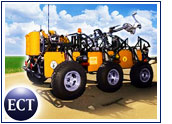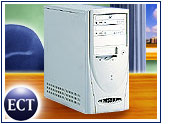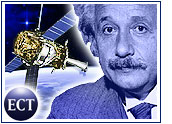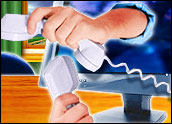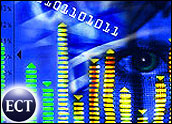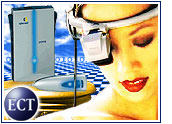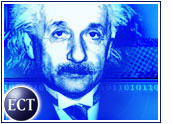
On April 20, a NASA rocket will lift off from Vandenburg Air Force Base carrying one of the most remarkable physics experiments ever attempted. Gravity Probe B will try to answer questions raised by Einstein’s General Theory of Relativity, proposed in the early years of the 20th century.
Einstein published not one, but two theories of relativity: the Special and the General. The Special dealt with the forces in atomic nuclei. The General Theory tried to explain gravity. But the two theories conflict with each other in some basic ways (and also conflict with general quantum physics), and the rest of Einstein’s life was devoted to the fruitless search for a unified theory that could model all the known data successfully. Many physicists now believe the General Theory might need updating.
Some of the predictions arising from these theories have been tested in the real world, but many are so hard to observe that they remain unproven to this day. Einstein’s ideas are actually among the least tested in scientific history. One of his most profound (and, to ordinary mortals, most incomprehensible) conclusions was that space itself can curve.
In 1918, two years after the General Theory was published, researchers predicted that the gravity produced by massive rotating objects (such as planets, stars and black holes) actually should drag nearby space-time around with them. Consider the orbits of the planets. We think of them as circular or elliptical, but according to the General Theory, they actually are traveling in straight lines: It is the very space containing them — the fabric by which they exist — that is curved by the sun’s gravity.
A similar effect — the slight warping of space by Earth’s much smaller gravitational field — is what Gravity Probe B will test.
Advanced Measurement
The engineering involved in this mission is so mind-boggling that any description risks devolving into strings of, “Oh, wow!” and, “You’re kidding!”
It was not until 1960 that a physicist, Leonard Schiff, working at Stanford University, came up with the idea of using gyroscopes, with their great inertial stability, to test the effects of gravity. But the relatively crude, earthbound gyroscopes of Schiff’s day were not up to the task of measuring forces as exquisitely tiny as those a small planet like Earth might produce.
Gravity Probe B, however, transcends those limitations. It will send a group of small gyroscopes in a satellite into a polar orbit 400 miles high, where they will stay for some 13 months, making measurements. If the theory is correct, relativistic forces will gradually change the direction of spin of a gyroscope orbiting the Earth, which otherwise should be constant. The experiment will measure those changes to an accuracy of 1 in 10,000.
Gaylord Green, program manager of the Gravity Probe B project, puts it simply: “This is the most sophisticated thing the human race has ever tried to put into space.”
Engineering Marvels
The device’s five gyroscope rotors are not disks, but spheres of fused quartz, each about the size of a ping-pong ball, coated with an ultrathin layer of the metal niobium. These are the most perfectly round objects ever created, rounder than anything in the universe except neutron stars. Each hangs suspended electrically in its own spherical cavity inside a 21-inch-long quartz block. The distance between a sphere and its cavity wall is just one thousandth of an inch, and the spheres spin at 10,000 rpm.
The gyroscope block is bonded firmly to a quartz-lensed telescope. The elements of its lenses aren’t even glued together like most; they are ground to such precision that they stick to each other by molecular attraction.
Gyroscopes and telescope are housed in a vacuum more complete than that of space itself, inside a nine-foot, cigar-shaped container called the “probe.” This, in turn, is held in a large vessel containing liquid helium, so the instruments operate at a temperature of just 1.8 degrees Kelvin above absolute zero. At that temperature, niobium is a superconductor, which is crucial to the measurement of the gyroscopes’ spin. Finally, the whole business is wrapped inside four concentric lead bags.
The point of all this is to eliminate the multitude of subtle influences that could disturb the rotors’ motion. The designers say that left undisturbed for a thousand years, they would still be spinning at 99 percent of their initial speed.
Once in orbit, the telescope searches for and then locks onto the exact center of a particularly distant star, which will provide a fixed reference. If the gyroscopes’ spin drifts relative to that, the warping of space itself — predicted by General Relativity — will have been demonstrated.
Role of Computer Technology
None of this can be accomplished without plenty of computing power. According to Gaylord Green, there are six RAD 6000 computers on the satellite. A RAD 6000 is a radiation-hardened version of an early IBM PC processor, now manufactured by U.K.-based BAE Systems. These computers will stream telemetry data at about 30 kilobits per second. The data will be stored in a solid-state recorder before being transmitted four times per day to two ground stations, one in Norway and the other in Alaska.
As the data reaches the ground, said Green, it’s “just raw bits — a serial data stream.” The stream is then demultiplexed to separate the many different kinds of information — divided into “operations” and “science” categories. The ops data is processed by a pod consisting of four Sun servers plus one SGI machine to generate the graphical displays. A second pod of four Sun servers provides redundancy. The applications used are all custom-built. “You kind of have to,” said Green, laughing.
The science mission data is pushed via a one-way link to preserve absolute mission security to a research center for analysis, using a Sun server and about 20 screens. The data will go through about 10 distinct processing steps that not only will look for gyroscope change, but also will filter out tiny data pollutants caused by physical factors or by the measuring process itself.
Whether Gravity Probe B proves Einstein to be right or wrong, it has already produced spinoff strategies and a number of technologies, and it has pushed the engineering envelope wider than ever before.

